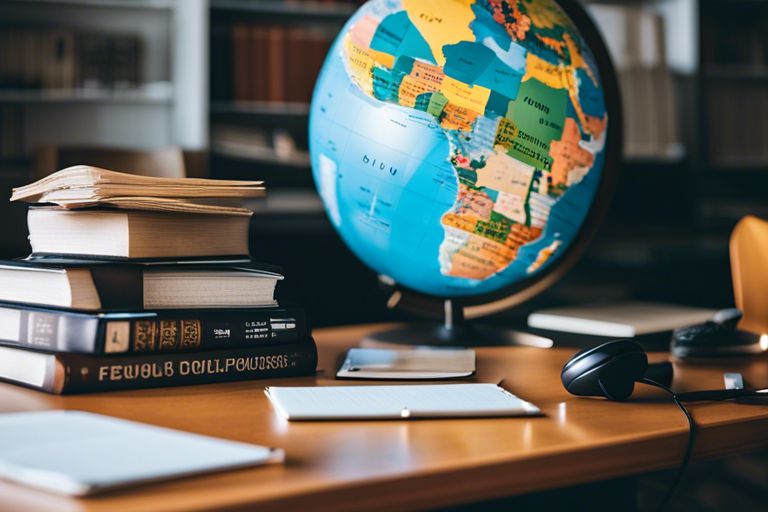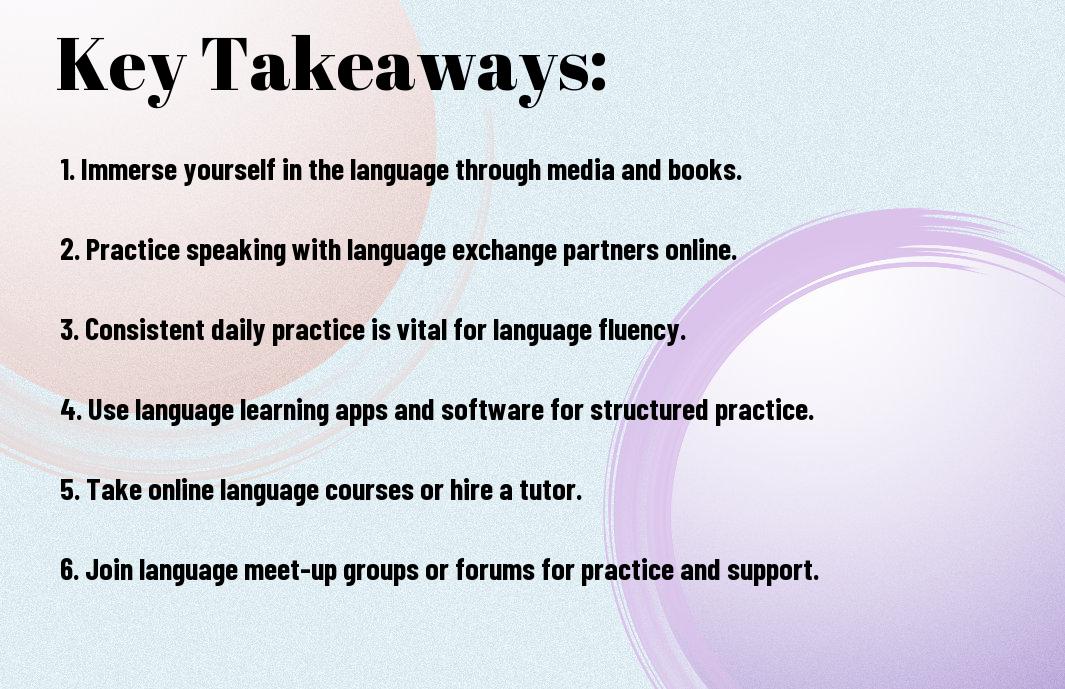Overcoming the barrier of not living in a country where your target language is spoken may seem daunting, but with the right strategies, dedication, and consistency, you can still achieve fluency. By immersing yourself in the language through online resources, language exchange programs, practicing regularly with native speakers, and incorporating the language into your daily life, you can make significant progress towards mastering a new language. Developing fluency is about embracing a growth mindset and turning every opportunity into a chance to learn and improve. Let’s explore effective ways for you to reach your language goals no matter where you are.

Key Takeaways:
- Immerse Yourself: Create an immersive environment by surrounding yourself with the language through music, movies, books, and podcasts.
- Practice Regularly: Consistent practice is key to developing fluency, so dedicate time each day to study, speak, and engage with the language.
- Utilize Language Learning Tools: Take advantage of online resources, language exchange programs, and language learning apps to supplement your learning and practice.

Setting Realistic Goals and Motivation
Before stepping into the journey of language learning, it’s important to set realistic goals and find the motivation that will drive you towards fluency. In a forum discussion on “Is it truly possible to become fluent without living in the country of the used language”, many language learners share their experiences and insights on how to succeed in learning a language effectively outside of its native environment.
Defining Fluency and Setting Achievable Targets
Realistic goals start with defining what fluency means to you. Fluency may differ from person to person – for some, it’s the ability to hold a casual conversation, while for others, it’s being able to discuss complex topics. Setting achievable targets such as mastering specific vocabulary or improving listening skills can help you progress steadily towards your ultimate fluency goal.
Finding Your Why: Staying Motivated on the Journey to Fluency
Defining your reason for wanting to learn a language is crucial to staying motivated through the ups and downs of the learning process. Whether it’s for career advancement, personal growth, or connecting with others culturally, understanding your ‘why’ can give you the drive to keep pushing forward, even when you face challenges.
Another aspect of motivation is celebrating small victories along the way. Acknowledging your progress, no matter how small, can help boost your confidence and keep you motivated to continue your language learning journey. Be mindful of, every step you take brings you closer to fluency!
Building a Language Learning Habit
Assuming you want to develop fluency in a language without living in a country where it is spoken, one of the key steps is to build a consistent language learning habit.
Creating a Schedule and Sticking to It
On your language learning journey, setting aside dedicated time each day or week for practice is crucial. By creating a schedule that works for you and sticking to it, you’ll establish a routine that reinforces your language learning efforts. Whether it’s early in the morning before work or in the evening before bed, find a time that suits your lifestyle and commit to it.
Using Language Learning Apps and Tools Effectively
Effectively incorporating language learning apps and tools into your routine can significantly enhance your learning experience. These resources offer interactive exercises, vocabulary practice, and even opportunities for live conversation practice.
Using language apps like Duolingo, Babbel, or Rosetta Stone can help you stay engaged and motivated while tracking your progress. Pairing these apps with additional tools such as language exchange platforms like Tandem or HelloTalk can provide opportunities to practice with native speakers and receive feedback on your skills.
Immersion Without Borders
All language learners dream of immersing themselves in a foreign country to learn a language effortlessly. However, the reality is that not everyone has the opportunity to pick up and move. But fear not, because with the right approach, you can create your very own language immersion experience right from the comfort of your home.
Accessing Native Materials and Media
Immersion in a language involves surrounding yourself with authentic materials and media in that language. Thanks to the internet, you have easy access to a wealth of resources such as books, movies, podcasts, and music in your target language. By incorporating these into your daily routine, you can train your ears to the cadence and rhythm of the language, improve vocabulary, and pick up on nuances that textbooks may not cover.
Finding Language Exchange Partners and Online Communities
On top of immersing yourself in native materials, interacting with native speakers is another key component for language fluency. There are numerous online platforms where you can connect with language exchange partners who are fluent in the language you are learning and are looking to practice your native language in return. These language partners can provide real-time feedback, cultural insights, and opportunities for authentic conversations, all of which are vital for improving your language skills.
Partners can also introduce you to online communities dedicated to language learning, where you can ask questions, share resources, and engage with like-minded individuals on your language learning journey. Joining these communities can provide additional motivation, support, and a sense of camaraderie as you strive to become fluent in the language of your choice.
Focused Practice for Fluency
To develop fluency in a language without living in a country where it is spoken, you need focused practice. This means honing your skills in listening, speaking, reading, and writing through targeted exercises and activities. Let’s probe into how you can achieve this.
Developing Listening and Speaking Skills
Listening is a fundamental skill in language learning. To improve your listening comprehension, immerse yourself in the language as much as possible. Listen to podcasts, watch movies or TV shows, and try to have conversations with native speakers. Speaking regularly, even if it’s just to yourself, can also help you become more comfortable with the rhythm and structure of the language. Consider finding a language exchange partner to practice speaking with and receive feedback on your pronunciation and sentence structure.
Improving Reading and Writing Abilities
Reading is a great way to expand your vocabulary and improve your comprehension skills. Challenge yourself with a variety of materials, from children’s books to news articles, to build your reading proficiency. Writing regularly in the language can also enhance your fluency. Keep a journal, write essays, or even participate in online forums or language exchange platforms where you can receive feedback on your writing. The more you practice, the more natural and confident you will become in expressing yourself in writing.
Developing your reading and writing abilities goes hand in hand with improving your overall language proficiency. Reading exposes you to different styles of writing and helps you grasp grammar rules and sentence structures. Writing regularly not only helps you practice applying the rules and vocabulary you’ve learned but also boosts your confidence in forming coherent thoughts and arguments in the language.
Overcoming Common Obstacles
Many obstacles may arise when trying to develop fluency in a language without being immersed in the culture where it is spoken. However, with determination and the right strategies, you can overcome these challenges and make significant progress in your language learning journey.
Dealing with Self-Doubt and Fear of Mistakes
Mistakes are a natural part of the language learning process. Don’t let the fear of making errors hold you back. Embrace your mistakes as opportunities to learn and improve. Remember that every native speaker was once a beginner too, and they made mistakes along the way. Be kind to yourself and have patience as you navigate through the ups and downs of learning a new language. Surround yourself with supportive resources such as language exchange partners, online communities, and language learning apps to boost your confidence and motivation.
Managing Time Constraints and Staying Consistent
Staying consistent in your language learning practice is key to making progress. Find pockets of time in your daily routine, such as during your commute, lunch break, or before bed, to dedicate to language study. Set realistic goals for yourself and create a study schedule that works for you. Use language learning tools like flashcards, podcasts, and language learning apps to make the most of your study time. Bear in mind, even short and consistent practice sessions can yield significant results over time.
Fear not if you have a busy schedule. You don’t need to spend hours a day studying to make progress. By staying consistent and incorporating language learning into your daily routine, even for just 15-30 minutes a day, you can build momentum and move closer to your fluency goals.

Leveraging Technology for Language Learning
Not being in a country where the language you are learning is spoken doesn’t have to limit your progress. Technology offers a plethora of resources that can help you immerse yourself in the language from the comfort of your own home.
Using Language Learning Podcasts and Videos
Learning from podcasts and videos is an engaging way to improve your language skills. By listening to native speakers and watching conversations in the target language, you can improve your listening comprehension, vocabulary, and pronunciation. Many language learning platforms offer podcasts specifically designed for learners at different levels, making it easier for you to find content that suits your needs.
Taking Online Courses and MOOCs
Videos can be a powerful tool in your language learning journey. Online courses and Massive Open Online Courses (MOOCs) provide structured lessons taught by language experts. These courses often include interactive exercises, quizzes, and opportunities for live practice sessions with instructors or other learners. With dedication and consistency, you can make significant progress in your language skills by taking advantage of these online resources.
To wrap up
As a reminder, developing fluency in a language without living in a country where it is spoken is absolutely achievable with dedication and the right approach. By immersing yourself in the language through online resources, language exchange programs, language meetups, and cultural events, you can constantly expose yourself to the language and practice regularly. Consistency is key, so make sure to set aside time each day to engage with the language in various forms.
Furthermore, don’t be afraid to make mistakes and keep pushing yourself out of your comfort zone. Embrace the challenges that come with learning a new language and see them as opportunities for growth. Recall, progress may be gradual, but with perseverance and a positive mindset, you can undoubtedly improve your language skills and achieve fluency over time. So keep at it, and enjoy the journey of learning a new language!
Q: How can I develop fluency in a language without living in a country where it is spoken?
A: One effective way to develop fluency in a language without living in a country where it is spoken is to immerse yourself in the language as much as possible. This can be done by watching movies, TV shows, listening to music, and reading books in that language.
Q: What are some other ways to improve fluency in a language while not residing in a country where it is spoken?
A: Another useful method is to find a language exchange partner or participate in language exchange programs online. This will give you the opportunity to practice speaking with native speakers and receive feedback on your language skills.
Q: Are there any online courses or resources that can help in developing fluency in a language?
A: Yes, there are numerous online courses and resources available, such as language learning apps, online language courses, and language learning websites. These tools provide structured lessons, practice exercises, and opportunities to interact with other language learners, which can greatly aid in improving fluency.


